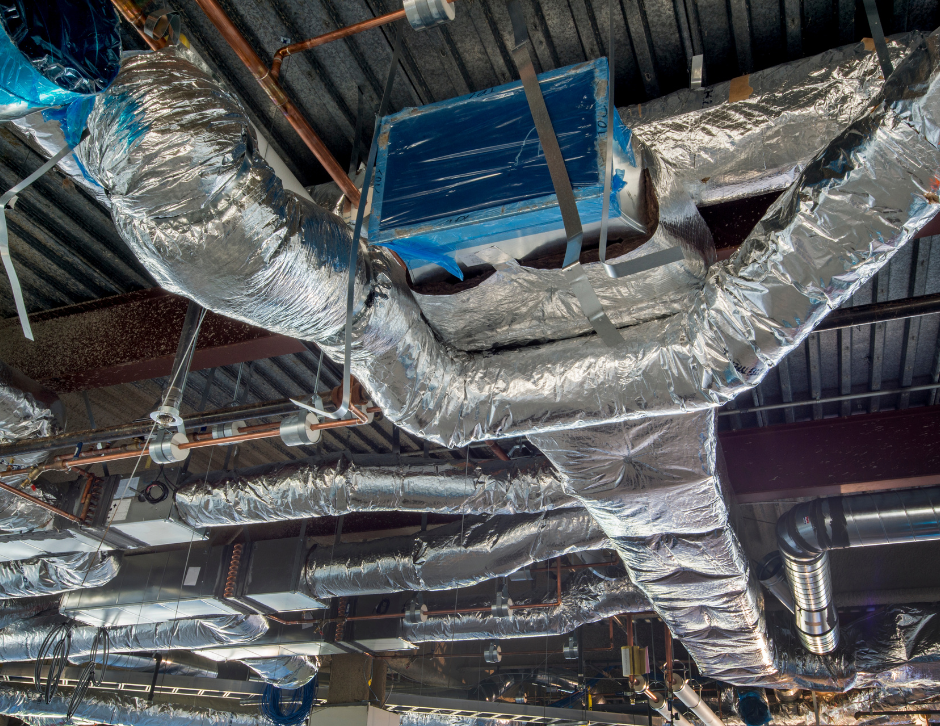by AdvancedSeal
Share
by AdvancedSeal
Share

Sealing the Building Envelope
Air leakage is one of the biggest sources of wasted energy in any home, especially in a barndominium or modern metal structure. Indiana’s energy code has clear rules for air barriers and duct insulation, and passing inspection means meeting or exceeding those standards.
A continuous air barrier is now required for all conditioned spaces. This means all the exterior walls, ceilings and floors separating living areas from outside or unconditioned areas must be completely sealed. Every gap, crack and penetration around windows, doors, electrical outlets, plumbing and HVAC must be filled with foam or caulk. Spray foam insulation is one of the most reliable ways to achieve this, as it expands to fill even the smallest spaces, creating a tight seal.
Indiana’s code requires homes to demonstrate air leakage no greater than 5 air changes per hour at 50 Pascals (ACH50), which is measured using a blower door test. Some areas of the state aim for even tighter numbers. Passing this test is now a standard part of getting your Certificate of Occupancy. Failing means costly repairs and delays, which is why we emphasize careful installation of all insulation and air barrier materials.
For barndominium builds, especially those with open-plan designs or exposed steel, achieving code-compliant air sealing is even more important. The unique combination of large surface areas, steel framing and variable floor plans requires a professional approach to both spray foam application and finishing details.
Duct Insulation Standards for Barndominiums
Heating and cooling ducts are often overlooked, but Indiana’s building code is clear: all ducts passing through unconditioned spaces like attics, crawl spaces, or garages must be insulated to R-8 if they are 3 inches or larger in diameter, and to R-6 for smaller ducts. This insulation prevents energy loss, stops condensation, and helps maintain even temperatures throughout your home.
Duct leakage is another key inspection point. Indiana follows the IECC standard, which limits duct leakage to 4 CFM25 per 100 square feet of conditioned floor area when tested with a pressure of 25 Pascals. This means well-sealed, insulated ducts are a must from the start of construction.
Spray foam isn’t just for walls; it can be used to seal the space around duct boots and plenum connections, reducing the chance of leaks and ensuring your heating and cooling system runs efficiently year-round.
Making sure your ducts are properly insulated and sealed also improves indoor air quality by preventing dust, allergens, and moisture from entering the airflow. For families with allergies or asthma, this is a valuable benefit.
For examples of successful code-compliant installations, see our Indiana commercial insulation services or crawl space insulation solutions.
Barndominiums and traditional homes alike need to meet Indiana’s modern energy codes for air sealing and duct insulation. Our expert team uses advanced spray foam techniques and pays close attention to every code detail.
If you are planning a project in Carmel, Rossville or throughout Central Indiana, contact us to ensure your build is up to code and energy efficient from day one.
STAY IN THE LOOP
Subscribe to our free newsletter.
Ceiling to Basement: Meeting R-Value Demands Building a barndominium in […]
What the 2018 IECC Means for Your Barndo Project If […]
When it comes to making smart home upgrades, summer is […]
If you’re dreading another sweltering Indiana summer, now is the […]




